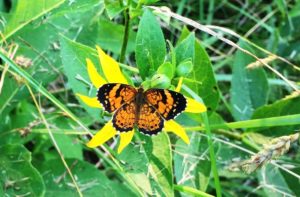Wildflowers and butterfly beauty is one of the best parts of rural life. As people go back to the woods or the fields, focusing on being self-sustaining and off-the-grid, one of the first questions they ask is: “What should I DO?” One of the most vital things I tell them is what they should NOT do!
No matter where Nature’s Guys are in the country, one thing we learned from our Dad is to avoid planting lawns. If you have wild plants in your yard, LEAVE THEM! If you do plant, then plant wildflowers, flowers, fruits and veggies instead! In fact, my brother on the West Coast (Vashon Island Treehouses) has signs all over his yard saying: “For the Bees!” We recognized a long time ago that if you don’t leave nature the way it is, or if you don’t at least plant some of your property “in reverse” (to get it back to the way it was) to attract bees, butterflies, birds and other pollinators, bad things happen to your yard!

As a result, I’ve left a large part of my property “overgrown”. Although much of it used to be lawn, some of it has grown up and started growing wildflowers. Crownbeard, daisies, poppies, thistles and other wildflowers have come and gone already. Now is the time for woodland sunflowers, trumpet creepers and butterfly milkweed, fantastically-colored wildflowers that have the extra benefit of attracting pollinators.
Within those wildflowers is the “Three for the price of one” concept.
1) The wildflowers, especially as they bloom, bring their own spectacular, colorful beauty
2) Those blossoms attract colorful butterflies, bees, wasps and other beautiful insects
3) Those “bugs” have the added benefit of being pollinators: They go to the flowers in my garden, making it possible for my garden to produce tomatoes, squash, cukes, and many other fruits and veggies.
Wildflowers Mean Less Work!
The other advantage of wildflowers and natural plants is also, very simply, it’s less work! Sometimes it does take some work to get it to the self-sustaining point. You might have to plan and plant to get to that point, but once it’s where it should be … it takes care of itself!
There’s probably another post in there about making self-sustaining be self-sustaining!
Enjoy this wildflower and butterfly video! (courtesy of #LightTheWorldNow)
